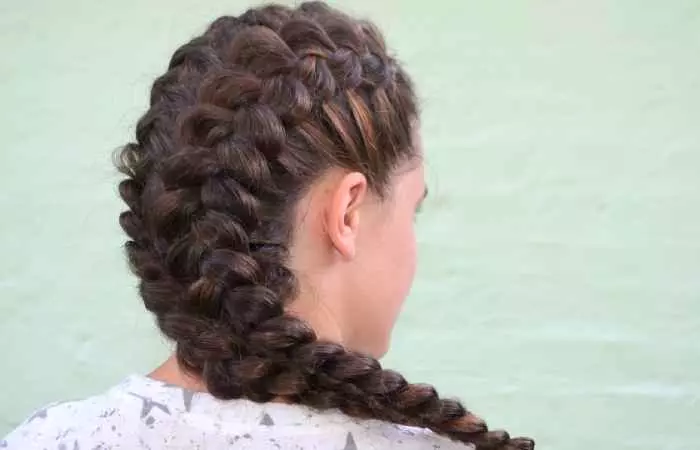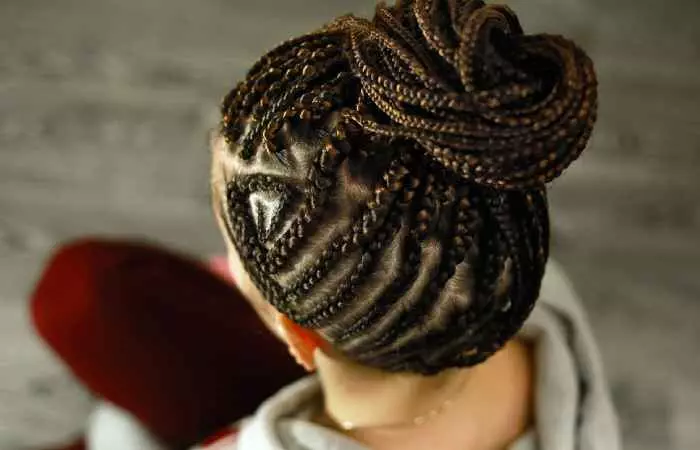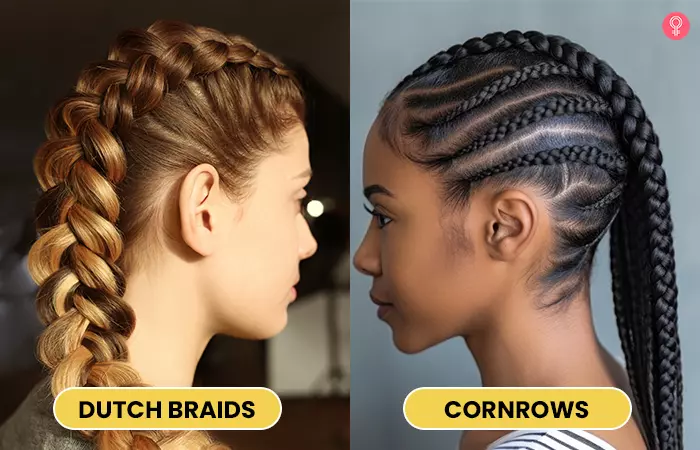What Are Dutch Braids?
The Dutch braid hairstyle, also known as inverted French braids or inside-out braids, is stylish, practical, and characterized by three sections of hair braided intricately along the scalp. Unlike traditional braids, where sections cross over each other, Dutch braids involve weaving sections under one another, creating a raised, 3D effect. This technique results in a braid that appears to sit on top of the hair rather than blending in. Dutch braids are versatile and can be worn in various styles, from simple, sporty looks to elegant updos. They are favored for the neat and textured look they create. The Dutch braid hairstyles can be worn in different variations such as Dutch braided crowns, Dutch braid ponytails, mohawk Dutch braid, double Dutch braids, and side Dutch braids. These styles look ethereal and add a Victorian charm to the overall look. These braids are popular among athletes and individuals with active lifestyles for their durability and ability to keep hair secure during physical activities. Isabel, a YouTuber, demonstrated how to achieve tight Dutch braids in the video. She said, “I love doing my hair like this, I do it all the time.” She also mentioned, “Whenever I do my hair like this, people will be like did you do that yourself and I’m like yeah it’s like the easiest thing. I do it all the time and it’s like so therapeutic for me (i).” To appreciate the cultural significance of Dutch braids, it is vital to explore their origins and historical roots. Let’s learn where Dutch braids originated, uncovering the rich heritage behind this timeless hairstyle. Keep reading!
Where Did Dutch Braids Originate?
Dutch braids have a long history. While they are commonly associated with the Netherlands, their origin isn’t solely Dutch. Rather, it is believed that South African immigrants brought this hairstyle to the Netherlands. In South Africa, braiding hair was a common practice among African women to shield their hair from the sun’s damage. This suggests that Dutch braids likely evolved from a fusion of cultural influences over time. Moving from the effortless chicness of the Dutch braids, let us now explore the whimsical allure of the cornrows. Check out the next section to find out everything you need to know about this style.
What Are Cornrows?
The cornrow braid hairstyle is a traditional African hairstyle where sections of hair are tightly braided close to the scalp, creating rows that resemble small, raised corn kernels. The process involves weaving three strands of hair together from the root to the tip in a neat and uniform pattern. Cornrows can be styled in various designs, from simple straight lines to intricate geometric shapes, and are often adorned with beads, shells, or other decorations for cultural significance or personal expression. This hairstyle is popular for its durability and low maintenance, making it a practical choice for individuals with active lifestyles or those looking for a long-lasting protective style. Additionally, cornrows are versatile and can serve as a foundation for other hairstyles like buns, ponytails, or extensions, allowing for endless creativity in hair styling. Rekik N, a YouTuber, shared a tutorial on how to cornrow hair, offering step-by-step instructions. In the video, she said, “I like to make sure that the section I’m working with is as detangled as possible and I am working on blow-dried hair (ii).” Having said that, let us delve into the rich cultural tapestry from which this iconic hairstyle emerged. Keep reading to explore the historical roots and cultural significance of cornrows to appreciate their enduring legacy.
Where Did Cornrow Braids Originate?
Cornrow braids have a long history, starting in Africa thousands of years ago. They have been important in African culture for ages, as seen in ancient civilizations like the Nok in Nigeria and Egypt. People wore them as far back as 3000 BC, as shown in paintings on the Sahara’s Tassili plateau. These braids also appeared in Roman, Greek, and Middle Eastern cultures. They weren’t just trendy; they showed social status, tribe, age, and beliefs. Different tribes and regions had their styles. Today, cornrows are popular worldwide. Now that you have learned all about hairstyles, check out the intricate differences to appreciate the diverse beauty and versatility of these popular braiding styles.
Difference Between Dutch Braids And Cornrows
Here is a breakdown of the differences between Dutch and cornrow types of braids.
Braiding Technique
Dutch braids involve braiding the hair by crossing sections under each other, creating a raised, 3D effect. The strands are woven under one another rather than over, resulting in a braid that appears to sit on top of the head. Cornrows are braids that are tightly braided to the scalp in a straight line, usually in rows close to each other. The braiding technique involves adding small sections of hair to each braid as you move along the scalp.
Hair Length And Type
Dutch braids work well on various hair lengths and textures, but they tend to be more prominent and easier to achieve on longer hair. Cornrows are typically best suited for shorter to medium-length hair and work well with coarse or tightly textured hair types.
Number Of Braids For Styling
Dutch braids are often styled with two braids, one on each side of the head, though they can also be styled with more or less depending on preference. Cornrows are usually styled in multiple rows, ranging from a few rows to many, depending on the desired look you want to go for.
Longevity
Dutch braids can last for several days with proper care, but they may loosen over time due to the weaving technique. Cornrows can last longer than Dutch braids, often staying intact for a week or more if maintained properly due to their close-to-the-scalp style.
Cost
Dutch braids are generally less expensive than cornrows since they require less time and more intricacy to create. Cornrows can be more costly due to the time and skill required to braid the hair closely to the scalp and create intricate patterns. If you are still wondering which one you should get, then scroll down to the next section.
Cornrows Vs. Dutch Braids – Which Ones Should You Get?
Deciding between cornrows and Dutch braids depends on various factors like your hair texture, personal style, and the occasion. Cornrows offer a sleek, close-to-the-scalp look, great for active lifestyles or when you want a longer-lasting style. On the other hand, Dutch braids stand out with their raised appearance, adding volume and texture to your hair. They are versatile and can be styled in various ways. Consider your preferences and needs to choose the best option for you. And now you must be curious about how to care for them to maintain their longevity and style. Take a look at the effective tips on caring for Dutch braid hairstyles in the section below.
How To Take Care Of Dutch Braids
Taking care of Dutch braids is essential to maintain their appearance and keep your hair healthy. Here is a guide on how to do it: Proper care for cornrows is also vital to ensure their longevity and keep your hair and scalp healthy. Learn effective techniques and tips on caring for cornrows to maintain their neat appearance and prevent any discomfort or damage. Keep scrolling!
How To Take Care Of Cornrows
Caring for cornrows is crucial to maintaining their appearance and the health of your hair and scalp. Here is a comprehensive guide on how to take care of cornrows: Deciding between cornrows and Dutch braids depends on various factors like your hair texture, personal style, and the occasion. Cornrows offer a sleek, close-to-the-scalp look, great for active lifestyles or when you want a longer-lasting style. On the other hand, Dutch braids stand out with their raised appearance, adding volume and texture to your hair. They are versatile and can be styled in various ways. Consider your preferences and needs to choose the best option for you. Taking care of both styles is crucial to maintaining their appearance and keeping your hair healthy, so be sure to follow the recommended care tips for each. Which one is more protective for my hair between cornrows and Dutch braids? Both cornrows and Dutch braids can be protective styles for hair, but Dutch braids distribute the tension all over the scalp due to their inverted weaving technique, potentially reducing strain on individual strands. However, your hair texture and styling preferences should be considered for optimal protection and comfort. Can I do Dutch Braids on my short hair? Yes, you can do Dutch braids on short hair, although the length and thickness of your hair may affect the size and appearance of the braids. Smaller sections and tighter weaving can help achieve Dutch braids on shorter hair lengths. Do Cornrows damage my hair? Cornrows may potentially cause hair damage if done too tightly or if left in for extended periods, leading to traction alopecia or breakage along the hairline (1). Proper technique, gentle handling, and avoiding excessive tension may help mitigate the risk of damage. Explore braiding mastery as the video unravels the secrets of Dutch braiding and cornrowing natural hair. Learn the techniques to create stunning and intricate styles. Watch now and elevate your braiding game!








